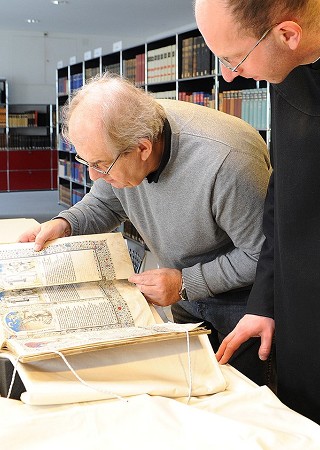Production: The Art of Facsimile Production
From the Original to the Authentic Replica
Fac simile (Lat.) means “make something similar”. The → facsimile editions produced by Quaternio Editions Lucerne follow this very principle step by step: from the photographs of the original manuscript via the strictly monitored printing process to the bookbinder’s craft. The focus is invariably on making the facsimile resemble the original as closely as possible. Specialists and experts contribute to achieving this aim by creating outstandingly good facsimiles which deserve to be described as “true to the original”.
Photographing the Original
The production of a facsimile starts with the photographer taking pictures of the original. For this purpose, some state-of-the-art equipment, including a special digital camera, a book cradle, spotlights and a computer, is mounted on the premises where the manuscript is kept. For safety reasons the manuscripts must remain at all times inside the institutions (→ libraries, archives, museums) which hold the corresponding collection.
Perfection in Every Printed Sheet
Processing the digital data at the computer, the lithographer prepares the colour prints and the gold prints. These processed digital data are the basis for the first print runs, which are then compared with the original, page by page. The smallest colour deviations have to be discerned and corrected accordingly. This is painstaking work requiring a specially trained eye, a great deal of concentration and many years of experience!


Perfection in Every Printed Sheet
To achieve the closest possible match with the medieval original, the printed sheets have to be corrected several times. Only then is the “imprimatur” given under the watchful eye of the manuscript curator. With great care the sheets of the edition are printed one by one on acid-free and special age-resistant paper which imitates not only the appearance, but also the feel of parchment.
Owing to the high quality standard provided by Quaternio Editions Lucerne, our staff are always welcome guests in libraries, archives and museums, for our work is a guarantee that the facsimile will in fact be true to the original.

The Reproduction of Gold and Silver
Gold or silver, sometimes appearing matte, but more often shining, are reproduced in a special process executed in separate print runs on the printing machine. In a time-consuming process prior to this, the lithographer has to make separate prints of all the gold and silver areas. Additional laborious steps are needed to reproduce the fine tooling of the gold and silver surfaces and to apply the patina imitating the traces of ageing, until the radiant appearance of the facsimile finally matches the original.


The Bookbinder’s Craft
After printing has been completed, the bookbinder starts to work. His traditional craft has hardly changed since the Middle Ages. By means of a technique that exactly imitates the edges of the original double leaves, the printed sheets are cut, folded and assembled into sections, usually forming quaternions, which are gatherings of four sheets. At the sewing frame, the sections are sewn together one by one to form the book-block. The headband is sewn by hand, copying the original with threads of different colours. In the next step, the book-block is attached to the book cover. To raise the bands on the spine evenly, the book is placed in a block press, and the bands are defined by nipping the leather around them.
Throughout the centuries, a great variety of materials has been used for medieval book covers: leather, velvet and silk, ivory, precious metals, enamel, and others. In each case this creates a great challenge for the bookbinder. Therefore Quaternio Editions Lucerne often calls in additional specialists, such as goldsmiths, experts in textile art and restorers, who are able to reproduce the binding in a way that is true to the original down to the smallest detail.


Would you like to learn more about the production of these true-to-the-original facsimiles by Quaternio Editions Lucerne, or are there further questions you would like to ask regarding any details of the facsimile production? Do not hesitate to → contact us. We look forward to hearing from you.



